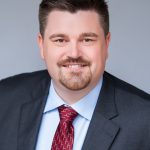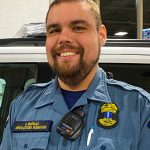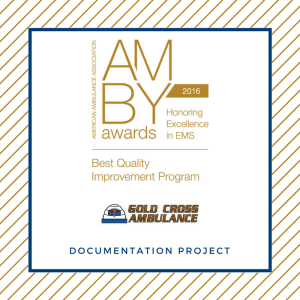40 Under 40: Rebecca Szeles (Richmond Ambulance Authority – Richmond, VA)
40 Under 40 nominees were selected based on their contributions to the American Ambulance Association, their employer, state ambulance association, other professional associations, and/or the EMS profession.
____
 Rebecca Szeles
Rebecca Szeles
Communications Supervisor
Richmond Ambulance Authority
Richmond, Virginia
____
Nominated by: Mark Tenia
Biography
Rebecca Szeles is a Nationally Registered Paramedic and Communications Supervisor at the Richmond Ambulance Authority (RAA). She is a Virginia Commonwealth University graduate with a Bachelor of Science in Biology. She is also a member of RAA’s Critical Incident Stress Management Team (CISM) and Peer Support Program (PSP).
Reason for Nomination
Supervisor Szeles has not only dedicated herself to her position, but has also committed herself to supporting the mental health and well-being of her co-workers. In 2017 Supervisor Szeles invited Jim Marshall from the 911-Training Institute to speak to staff about resiliency. In 2018, she went through training to become a member of our Critical Incident Stress Management (CISM) team. CISM helps providers deal with traumatic events such as line of duty or pediatric deaths, and Mass Casualty Incidents (MCI). Supervisor Szeles realized more could be and needed to be done to help RAA’s providers on a day to day basis.
After becoming a member of CISM, Supervisor Szeles spearheaded efforts to create a Peer Support Program at RAA. The program was created as another tool to help paramedics and EMTs deal with the day to day stresses that come with the job. In 2018, Supervisor Szeles invited a leading expert in Peer Support to help train staff members who would become the first members of RAA’s Peer Support Team. She assisted in the creation of an awareness campaign promoting the importance of mental health and using resources like CISM, Peer Support, and external support services. She also assisted the Virginia Office of EMS by appearing in a Public Service Announcement titled “Make the Call.” The video was viewed more than 34,000 times on social media.
Supervisor Szeles has also overseen RAA’s resiliency training aimed at helping our providers bounce back from difficult events and cope with stresses from those events in a healthy way. The program helps Communication Officers, (or System Status Controllers) Paramedics and EMTs effectively manage stress and fosters professional development. Since our Peer Support Team launched in December 2018 the organization has had 122 recorded interactions with staff members. Our number of contacts has steadily risen as awareness of the program has increased. 83.6% of our contacts have been work related and 20.5% have been related to CISM. 16.4% of our contacts have involved non-work related issues. Of the employees that have taken advantage of the programs, we have seen positive outcomes and successful performances in their respective positions. Supervisor Szeles has played a key role in those successes.
RAA is now getting requests from other agencies from within and outside the state to help set up programs of their own. The work Supervisor Szeles has done is helping a wider range of EMS providers outside of RAA.
Last year Supervisor Szeles also took on major responsibilities in addition to her regular duties when our Director of Communications went on leave for surgery. For three months she stepped into the role to fill in gaps, producing daily and monthly performance reports, managing the interview and hiring process for new employees, as well as answering any calls or responding to any issues that needed to be addressed by the Communications Center. Supervisor Szeles has proven to be flexible, hardworking and an invaluable asset that has made her co-workers and our agency stronger.
____
View all of the 2020 Mobile Healthcare 40 Under 40 Honorees

 perations, Southeast Tennessee/Northwest Georgia
perations, Southeast Tennessee/Northwest Georgia







 The documentation review process at Gold Cross Ambulance had not changed much since the day of paper trip tickets. Retrospective documentation feedback was being given to crews, but they were not fully utilizing the capabilities of their technology to analyze the feedback and make significant improvements. Gold Cross Ambulance hypothesized that improved documentation goals would lead to better patient care and increased reimbursements. They knew they needed to make improvements in the review process and to better utilize the technology that was already in place. In addition to the documentation goals, they identified the opportunity to work some small, but significant, clinical improvements into a documentation project. One initial focus of clinical improvement was making sure the field crews were obtaining at least two sets of vital signs on every patient, and properly documenting these vital signs in the electronic patient care report (ePCR). Of all the performance indicators we measure, trending of vital signs touches every patient contacted. Educators from Utah EMS for Children shared research citing “inadequate recognition of and response to hypotension and hypoxia was associated with higher odds of disability and death” (Hewes H., 2016). This was such a basic thing to measure, but it had potential to impact every contacted patient. Gold Cross know that vital signs were an area in which they could improve, while also meeting their documentation goals. To do so, they implemented the following:
The documentation review process at Gold Cross Ambulance had not changed much since the day of paper trip tickets. Retrospective documentation feedback was being given to crews, but they were not fully utilizing the capabilities of their technology to analyze the feedback and make significant improvements. Gold Cross Ambulance hypothesized that improved documentation goals would lead to better patient care and increased reimbursements. They knew they needed to make improvements in the review process and to better utilize the technology that was already in place. In addition to the documentation goals, they identified the opportunity to work some small, but significant, clinical improvements into a documentation project. One initial focus of clinical improvement was making sure the field crews were obtaining at least two sets of vital signs on every patient, and properly documenting these vital signs in the electronic patient care report (ePCR). Of all the performance indicators we measure, trending of vital signs touches every patient contacted. Educators from Utah EMS for Children shared research citing “inadequate recognition of and response to hypotension and hypoxia was associated with higher odds of disability and death” (Hewes H., 2016). This was such a basic thing to measure, but it had potential to impact every contacted patient. Gold Cross know that vital signs were an area in which they could improve, while also meeting their documentation goals. To do so, they implemented the following: